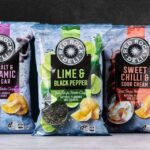The positive effect of a functional food may include the maintenance of health or well-being or a reduction in the risk of suffering a given illness. Aromatic herbs and spices conform to this definition in several ways, explains T. John Zachariah.
Table of Contents
Functional food products have been defined as providing an added health benefit over and above the food product’s traditional nutritional value. The concept of functional food is, however, complex and may refer to many possible aspects, including food obtained by any process, whose particular characteristic is that one or more of its components, whether or not that component is itself a nutrient, affects the target function of the organism in a specific and positive way, promoting a physiological or psychological effect beyond the merely nutritional. The positive impact of a functional food may include the maintenance of health or well-being, or a reduction in the risk of suffering a given illness. Aromatic herbs and spices conform to this definition in several ways.
The main consumer motive for purchasing functional foods is to use foods either to help prevent chronic illnesses such as cardiovascular disease, Alzheimer’s disease and osteoporosis, or to optimise health. This segment incorporates fortified/functional foods, but also includes organic foods, “better for you” food and beverages (BFY), “naturally healthy” (NH) foods, products catering to food intolerance, vitamins and dietary supplements, traditional herbal products, slimming products and sports nutrition. Of this market, the part of the functional food alone was valued at US$168 billion in a global market.
The product development process for new functional food products has been described as complex, expensive and risky. The grey area where food and health markets merge has generated a need for new competencies for personnel and enterprises working in functional food product development (FFPD).
Spices and Health
Spices are an important part of human nutrition. It is well documented in literature how spices impart flavour and reduce the need for salt and fatty condiments, improve digestion and provide the organism with extra antioxidant that prevents the appearance of physiological and metabolic alterations.
One of the changes secured in the food industry is from the concept of ‘adequate nutrition’ to ‘optimal nutrition’, which includes the potential of food to promote health, improve well-being and reduce the risk of developing disease. Learn how sustainability trends are influencing spice-related innovations.
The positive effect of a functional food may include the maintenance of health or well-being or a reduction in the risk of suffering a given illness. Functional food may be obtained by modifying one or more of the ingredients or by eliminating them.
Culinary Herb and Spice
Spices can be leaf (eg bay leaf), buds (clove), bark (cinnamon), root (ginger), berries (grain of black pepper), seeds (cumin) or even stigma of flower (saffron). Both spices and herbs can be used fresh, dried, whole, chopped or ground, and due to their colour, aroma and / or flavour characteristics, they are used in the preparation of foods and drinks. Spices and herbs contain proteins, fibre, sugars, essential oils, minerals, pigments, besides bioactive compounds such as phenolic acids, sterols and cumarins. Many of the functional properties attributed to spices associate with the presence, type and concentration of phenolic compounds, although exact composition depends on several factors such as the plant part used, vegetative state, environmental conditions, harvesting techniques, etc
Other compounds present in spices are the essential oils, which, due to their content in terpenes, monoterpenes, and susquiterpenes (as hydrocarbons, alcohols, ketones, etc.), are responsible for many functional properties. These are composed of more than 70 components, some of which may represent more than 85% of the total content.
Phenolic Compounds
Phenolic compounds in any form present in spices and herbs, whether simple phenols, flavonoids, flavanones, flavanols, anthocyanins, etc, are responsible for their functional properties. Properties of spices such as antioxidant, antibacterial, antiviral, anti-inflammatory capacities, cardioprotective and anti-carcinogenic effects and their ability to act as inhibitors of platelet aggregation are significant. Phenolic compounds contribute to colour and taste. Simplest phenols are liquid or solid with a low fusion point and high boiling point, as they form hydrogen bonds. They are easily oxidised, which is why they frequently appear to be coloured.
Read about the growing demand for natural sugar and salt alternatives.
Terpenes
These groups of chemicals are the fundamental components of essential oils. They all result from the condensation of isoprenic units. Among their different forms are monoterpenes, diterpenes and sesquiterpenes. They are extremely volatile and have been demonstrated to possess multiple functional properties, including antioxidant, antimicrobial and antiviral capacities.
Learn how India is enhancing spice export strategies.
Antioxidant Properties
Spices have shown their ability to slow down the process of lipidic oxidation. This process is one of the principal causes of food spoilage and may occur during the storage of raw materials, processing or at the storage of the final product. To avoid such spoilage, the food industry has resorted to synthetic antioxidant formulations, some of the most commonly used being butylated hydroxy toluene (BHT), butylated hydroxyl anisole (BHA) and propyl gallate. However, because of their synthetic origin, their safety and efficacy are frequently questioned. The result has been a growing interest in compounds of vegetable origin which show antioxidant potential. Explore natural antioxidants and their role in food safety.
Possible mechanisms of antioxidant action by spices may be by scavenging free radicals, hydrogen donation, the chelating of metallic ions or the capacity to act as substrate of radicals such as superoxide or hydroxyl.
Free radicals, produced as a result of normal biochemical reactions in the body, are implicated in contributing to cancer, atherosclerosis, ageing, immune suppression, inflammation, ischemic heart disease, diabetes, hair loss, and neurodegenerative disorders such as Alzheimer’s disease and Parkinson’s disease. The human body possesses innate defence mechanisms to counter free radicals in the form of enzymes such as superoxide dismutase, catalase, and glutathione peroxidase. Vitamin C, vitamin E, selenium, β-carotene, lycopene, lutein and other carotenoids have been used as supplementary antioxidants.
Apart from these, plant secondary metabolites such as flavonoids and terpenoids play an important role in the defense against free radicals Plant parts of medicinal plants including spices (roots, leaves, branches/stems, barks, flowers, and fruits) are commonly rich in phenolic compounds, such as flavonoids, phenolic acids, stilbenes, tannins, coumarins, lignans and lignins.
They have multiple biological effects, including antioxidant activity. The antioxidant properties of phenolic acids and flavonoids are due to their redox properties, ability to chelate metals and quenching of singlet oxygen. Flavonoids, which are partly responsible for the pigmentation of flowers, fruits and leaves, are subdivided into flavanols, flavonols, flavones, flavanones and anthocyanins based on the saturation of the flavan ring and also their hydroxylation. They occur mostly as glycosylated derivatives, sometimes conjugated with sulphate or organic acids.
Antibacterial Properties
Many techniques have been used to preserve foods from microbial attack. The food industry is exploring ways to replace synthetic preservatives with natural ones, and spices tend to be the primary source of these. Again, spices and their essential oils are promising natural antimicrobials.
Role of Spices in health benefits
Spices are esoteric food adjuncts that have been used as flavouring and colouring agents and as preservatives for thousands of years. Spices have also been recognised to possess medicinal properties. With the advancement in the technology of spices and on the knowledge of the chemistry and pharmacology of their active principles, their health benefits have been investigated more thoroughly in recent decades. Many health benefits of these common food adjuncts have been recognised by pioneering experimental research involving both animal studies and human trials.
These studies documented digestive stimulant action, hypolipidemic effect, antidiabetic influence, antilithogenic property, antioxidant potential, anti-inflammatory property, antimutagenic, and anticarcinogenic potential of spices. Among these, the hypocholesterolemic and antioxidant properties of a few specific spices have far-reaching nutraceutical value. These beneficial physiological effects also have the potential for therapeutic application in a variety of disease conditions.
Discover how traditional foods can play a role in modern health.
These groups of esoteric food adjuncts have been in use for thousands of years to enhance the sensory quality of foods, and the quantity and variety consumed in tropical countries is particularly extensive. These spice ingredients impart characteristic flavour, aroma, or piquancy and colour to foods. Some spices, like fenugreek, can also modify the texture of food. It is a common experience that their distinct aroma stimulates the appetite.
Not only are spices used as flavourings and seasonings, but many are also used in perfumery, cosmetics, and toiletries. In addition, several spices have long been recognised to possess medicinal properties such as tonic, carminative, stomachic, antispasmodic, and antihelminthic, as listed in Table 2. Although these observations are largely empirical, these undoubtedly efficacious attributes have earned them pharmacological applications in the indigenous system of medicine, not only in India, but in other countries as well.
The affluence generated by the spice trade was responsible for several historic voyages and discoveries of new lands. Today, the annual global spice trade is estimated to be in the order of $2000 million, involving a quantity of 500,000 tons. India is the largest producer, consumer, and exporter of spices. India’s annual spice exports amount to 2.3 lakh tons and have a value of Rs.16,000 million. Black pepper is the major spice commodity exported from India, followed by red pepper, turmeric, ginger, cardamom, seed spices, curry powders, spice oils, and oleoresins.
Spices are not only used individually but also in the form of spice mixtures, known as “curry powder,” to suit different tastes and dishes. Although spices have never been considered to contribute anything to human nutrition, this group of food adjuncts has been used in human diets for centuries as flavour modifiers to make food more palatable. Interestingly, the protein content in spices varies from 4.5% in rosemary leaves to 31.5% in mustard, and the fat level ranges from 0.6% in garlic to 42.6% in mustard.
The ash content can be anywhere from 2.3% in marjoram to 16.7% in basil leaves reflecting high mineral levels in them. Some spices contain significant levels of vitamins and minerals, which cannot be ignored. A few spices are also rich sources of dietary fibre,. Amongst common spices consumed, the dietary fiber is highest in red pepper, as high as 43.3%, although black pepper (27.8%), coriander (36.2%) , cumin (23.0%), fennel (28.7%), and fenugreek (33.5%) also are rich sources of dietary fiber, both soluble as well as insoluble. The components of spices responsible for the quality attributes have been designated as “active principles” and in many instances, they are also responsible for the beneficial physiological effects of spices.
Extensive animal studies carried out to evaluate the safety aspects of spices have indicated that even at much higher dietary levels (up to 100 times the normal intake), red pepper, black pepper and turmeric have no adverse effects on growth, organ weights, Feed Efficiency Ratio, nitrogen balance, and blood constituents. In the past two to three decades, many more beneficial physiological effects of spices have been experimentally documented, which suggests that the use of these food adjuncts extends beyond taste and flavour. During recent years, spices and their active principles have been studied as possible ameliorative or preventive agents.

Hypolipidemic/Hypocholesterolemic Effect
The importance of serum cholesterol levels and lipoproteins in relation to atherosclerosis and coronary heart disease is well known. In view of this, there has been a continuous search for blood cholesterol-lowering agents, and dietary adjuncts have been especially screened for this, as it would be most advantageous. Some of the commonly consumed spices were naturally evaluated for possible hypocholesterolemic action in a variety of experimental situations in both animals and humans.
The spices fenugreek, red pepper, turmeric, garlic, onion and ginger were found to be effective as hypocholesterolemic agents under various conditions of experimentally induced hypercholesterolemic/ hyperlipemia. Further, fenugreek, onion, and garlic are effective in humans with hyperlipemic conditions. Curcumin and capsaicin, the active principles of turmeric and red pepper, respectively, are also efficacious at doses comparable to calculated human daily intake.
Turmeric and curcumin showed excellent hypocholesteremic effects in experimental animals. However, endogenous cholesterol synthesis was not affected. Extracts of garlic and onions inhibit platelet aggregation and lower cholesterol levels. The raw form is more effective than the cooked form. About 50g of onion and garlic, corresponding to 5-6 cloves per day, may be adequate to bring these beneficial effects.

Other work also documents hypocholesterolemic effects of spices. Fenugreek seeds were hypocholesterolemic in rats with hyperlipidemia induced by either a high-fat or a high-cholesterol diet. Defatted fenugreek seed was effective in diabetic hypercholesterolemia in dogs and in humans. The hypolipidemic effectiveness of turmeric/curcumin, red pepper/capsaicin and of onion and garlic has been periodically reviewed in recent years by different authors.
Some researchers feel that large amounts of garlic (up to 20 cloves) are needed to prove clinical effectiveness. This is indeed true because large quantities are required to provide relatively very small amounts of active oils or other derivatives. But with the introduction of dehydrated garlic powder containing a standardised level of the parent sulfur compound, alliin, effective clinical work could be undertaken with the relatively low and acceptable daily dosage of 300-900mg (= 1 clove of garlic). This level produced a consistent 10%-13% reduction in blood cholesterol and triglycerides.
In a recent study, dietary supplementation with aged garlic extract showed better beneficial effects, relative to fresh garlic, on the lipid profile and blood pressure of moderately hypercholesterolemic subjects. In another study, garlic supplementation significantly decreased both total and LDL cholesterol in hypercholesterolemic subjects. Co-administration of garlic with fish oil had a more beneficial effect on serum lipid and lipoprotein concentrations by providing a combined lowering of total cholesterol, LDL cholesterol, and triglyceride concentration as well as the ratios of total cholesterol to HDL cholesterol and LDL cholesterol to HDL cholesterol.
The anti-platelet aggregation, the anti-platelet adhesion and the antiproliferation properties of aged garlic extracts appear to contribute more to cardiovascular protection than do the hypolipidemic properties. Apart from the hypocholesterolemic effect of capsaicin, its beneficial impact on overall lipid metabolism under different conditions of lipemia has also been reported. In a further study, capsaicin treatment is also shown to enhance energy metabolism in rats.

Antilithogenic Effect
The inhibitory effect of a curcuma mixture on lithogenesis in rabbits has been reported. Studies on experimental induction of cholesterol gallstones in mice and hamsters by feeding a lithogenic diet have revealed that the incidence of gallstones is 40%-50% lower when the animals are maintained on 0.5% curcumin or 5 mg% capsaicin-containing diet. Animal studies have also revealed significant regression of preformed cholesterol gallstones by these spice principles in a 10-week feeding trial. The possibility of such a beneficial prevention and regression of cholesterol gallstones by other known hypocholesterolemic spices remains to be examined. The antilithogenicity of curcumin and capsaicin is considered to be due to the lowering of cholesterol concentration and enhancing the bile acid concentration, both of which contribute to lowering the cholesterol saturation index and, hence, reduce crystallisation. In addition to their ability to lower the cholesterol saturation index, the antilithogenecity of these spice principles may also be due to their influence on biliary proteins.
Antidiabetic Potential
As part of the dietary treatment of diabetes, there has been a continuous search for novel antidiabetic drugs from plant sources. Spice, the natural and common food adjuncts, have also been examined in this direction, and their efficacy has recently been reviewed. A considerable number of human experiments have also been carried out on these aspects, in addition to experimentally induced animal diabetic models. Fenugreek, garlic, onion, turmeric, and cumin were studied for their antidiabetic potential, but human trials are limited other than with fenugreek. Fenugreek, turmeric or its active principle curcumin, onion or its active principle allyl propyl disulfide, garlic, and cumin were observed to improve glycemic status in diabetic animals with noninsulin-dependent diabetes mellitus (NIDDM) patients.

Studies have unequivocally demonstrated the antidiabetic potential of fenugreek in both type-I and type-II diabetes. The addition of fenugreek seeds to the diets of diabetic patients or animals results in a fall in blood glucose and improvement in glucose tolerance. Antidiabetic properties of sub-fractions of fenugreek seeds have also been studied. The hypoglycemic effect is attributed to the fibre and gum, which constitute as much as 52% of the seeds. The spice probably delays gastric emptying by direct interference with glucose absorption, and the gel-forming dietary fibre reduces the release of insulinotropic hormones and gastric inhibitory polypeptides.
Coumarin and trigonelline are considered to be responsible for the observed hypoglycemic activity of this spice. Recent reports showed that 4-hydroxy isoleucine has insulinotropic activity and might at least partly account for the antidiabetic property of fenugreek seeds.
Garlic and onion are two other spices that have been widely used for their antidiabetic potential. Both these spices were shown to be hypoglycemic, and the potency of garlic and onion has been attributed to the sulfur compounds, namely di (2-propenyl) disulfide and 2-propenylpropyl disulfide, respectively. Animal studies indicate that the isolated compounds possess as much as 60%-90% of the hypoglycemic potency of tolbutamide. The mechanism of hypoglycemic action probably involves direct or indirect stimulation of the secretion of insulin by the pancreas. In addition, it is also suggested that these disulfide compounds have an insulin-sparing effect by protecting SH inactivation by reacting with endogenous thiol-containing molecules such as cysteine, glutathione, and serum albumins.
Turmeric is another spice claimed to possess a beneficial hypoglycemic effect and to improve glucose tolerance in a limited number of studies. Nephropathy is a common complication in chronic diabetes. High blood cholesterol is an added risk factor that determines the rate of decline of kidney function in diabetics. Hypercholesterolemia is a regular biochemical abnormality in diabetes mellitus and nephropathy is one of the secondary eventualities of this disease.
Extensive studies with diabetic rat models were carried out to examine whether with hypolipidemic spices supplementation in the diet would influence renal lesions associated with diabetes by virtue of their possible cholesterol-lowering effect. Dietary curcumin and onion have been found to have a promising ameliorating influence on the severity of renal lesions in streptozotocin diabetic rats. Hypocholesterolemic effects and the ability to lower the extent of lipid peroxidation under diabetic conditions are implicated in the amelioration of renal lesions.
Capsaicin is beneficial in diabetic neuropathy. In an eight-week, double-blind, placebo-controlled study with parallel randomised treatment conducted by 12 independent investigators involving 219 patients, tropical application of 0.075% capsaicin cream was practical in pain management. The listed spices may be used in conjunction with anti-diabetic drugs to have better therapeutic potential and to minimise drug dosage. Fenugreek seeds (25-50g), garlic (5-6 cloves)/onion (50g), and turmeric powder are incorporated in the daily diet of diabetics.
The fenugreek seeds contain polyphenolic compounds, which have been correlated to the beneficial health effects of fenugreek. Steroidal saponins in fenugreek seeds increase appetite while inducing hyperinsulinemia and decreasing plasma total cholesterol levels. It is also a rich source of polysaccharides and galactomannan. However, reports are not available for its lipophilic constituents and water-soluble saccharides other than galactomannan. In addition, potential lipid peroxidation (LPO), cyclooxyganase (COX-1 and -2) enzyme inhibitory activities of its constituents have not been studied.
Quality profile of important spice varieties
The medicinal properties and aroma quality of spices are attributed to the volatile oils present in spices. The non-volatile part of the spice extracted using organic solvents is called the oleoresin. The high-yielding varieties of black pepper, cardamom, ginger, turmeric, nutmeg and cinnamon released by the Indian Institute of Spices Research, along with the quality profile, are tabulated (seetables).
Encapsulation of polyphenols
Microencapsulation, developed approximately 60 years ago, is defined as a technology of packaging solids, liquids, or gaseous materials in miniature, sealed capsules that can release their contents at controlled rates under specific conditions. The packaged materials can be pure materials or a mixture, which are also called coated material, core material, actives, fill, internal phase or payload. On the other hand, the packaging materials are called coating material, capsule, membrane, carrier or shell, which can be made of sugars, gums, proteins, natural and modified polysaccharides, lipids and synthetic polymers
Microcapsules are small vesicles or particulates that may range from sub-micron to several millimetres in size. Many morphologies can be produced for encapsulation, but two major morphologies are more commonly seen: one is mononuclear capsules, which have a single core enveloped by a shell, while the other is aggregates, which have many crores embedded in a matrix. The presence of technologies influences their specific shapes in the different systems, and by the core and wall materials from which the capsules are made.
. Explore emerging food technologies for product development.
Various techniques are used for encapsulation. In general, three steps are involved in the encapsulation of bioactive agents: (i) the formation of the wall around the material to be encapsulated; (ii) ensuring that undesired leakage does not occur; (iii) ensuring that undesired materials are kept out. The current encapsulation techniques include spray drying, spray cooling/chilling, extrusion, fluidised bed coating, coacervation, liposome entrapment, inclusion complexation, centrifugal suspension separation, lyophilisation, cocrystallisation, and emulsion.
The main objective of encapsulation is to protect the core material from adverse environmental conditions, such as undesirable effects of light, moisture, and oxygen, thereby contributing to an increase in the shelf life of the product and promoting a controlled liberation of the encapsulate.
In the food industry, the microencapsulation process can be applied for a variety of reasons: (i) protection of the core material from degradation by reducing its reactivity to its outside environment; (ii) reduction of the evaporation or transfer rate of the core material to the outside environment; (iii) modification of the physical characteristics of the original material to allow easier handling; (iv) tailoring the release of the core material slowly over time, or at a particular time; (v) to mask an unwanted flavour or taste of the core material; (vi) dilution of the core material when only small amounts are required, while achieving uniform dispersion in the host material; (vii) to help separate the components of the mixture that would otherwise react with one another. Food ingredients of acidulants, flavouring agents, sweeteners, colorants, lipids, vitamins and minerals, enzymes and microorganism, are encapsulated using different technologies.
Polyphenols constitute one of the most numerous and ubiquitous groups of plant metabolites. They are an integral part of both human and animal diets, which possess a broad spectrum of biological activities, including antioxidant, anti-inflammatory, antibacterial, and antiviral functions. A large body of preclinical research and epidemiological data suggests that plant polyphenols can slow the progression of certain cancers, reduce the risk of cardiovascular disease, neurodegenerative disease, diabetes, or osteoporosis, suggesting that plant polyphenols might act as potential chemopreventive and anticancer agents in humans.
Unfortunately, the concentrations of polyphenols that appear effective in vitro are often of an order of magnitude higher than the levels measured in vivo. The effectiveness of nutraceutical products in preventing disease depends on preserving the bioavailability of the active ingredient. This is a big challenge, as only a small proportion of the molecules remain available following oral administration, due to insufficient gastric residence time, low permeability and/or solubility within the gut, as well as their instability under conditions encountered in food processing and storage, or in the gastrointestinal tract, all of which limit the activity and potential health benefits of the nutraceutical components, including polyphenols.
The delivery of these compounds, therefore, requires product formulations and manufacturers to provide a protective mechanism that can maintain the active molecular form until the time of consumption, and deliver this form to the physiological target within the organism. Another unfortunate trait of polyphenols is their potential unpleasant taste, such as astringency, which needs to be masked before incorporation into food products.
Conclusion
Functional food product development (FFPD) is a complex process with success factors that are somewhat different from those of traditional new food product development. A greater focus on a product-oriented NPD portfolio and diverse multiple external partners has been suggested as key factors for accelerating the progress of FFPD.
The food industry earns only 21% of its turnover from NPD launches, which is well below the consumer packaged goods sector industry average of 38%. A vast majority of new food products can be considered truly innovative products. Recently, a rising trend in the health and wellness market has provided an opportunity for addressing this balance and moving toward truly differentiated food products, having unique customer values, which can also be viewed favourably in the wake of an increasingly competitive consumer goods market.
Further, consumers no longer consider private labels as a weak alternative to branded food products. This situation is especially challenging for branded food manufacturers, who want to maintain their leading edge while being competitive in price and quality of products. Those companies that want to move out of traditional competitive behaviour and enter into new markets will need to develop unique competencies to outperform the competitors in technological and production skills, whilst making their business viable in the long term.
Although not all functional foods launched in the past or to be launched in the future have been and will be classified as radical new products, a truly differentiated innovative functional food product development programme will be an effective tool for maintaining competitiveness. Moreover, FFPD may cause a departure from the existing traditional NPD practices and business attitude toward its innovation and production skills/ systems.
FAQs on Functional Foods and Phyto Medicines
What are functional foods?
Functional food products have been defined as providing an added health benefit over and above the food product’s traditional nutritional value.
Why should we buy functional foods?
The main consumer motive for purchasing functional foods is to use foods either to help prevent chronic illnesses such as cardiovascular disease, Alzheimer’s disease and osteoporosis, or to optimize health.
What are the positive effects of functional foods?
The positive effect of a functional food may include the maintenance of health or well being or a reduction in the risk of suffering a given illness.
Role of Spices in health benefits
Spices are esoteric food adjuncts that have been used as flavouring and colouring agents and as preservatives for thousands of years. Spices have also been recognized to possess medicinal properties.
Quality profile of spices
The medicinal property and aroma quality of spices are attributed to the volatile oils present in spices. The non-volatile part of spice extracted using organic solvents is called the oleoresin.
References
- Rao Sanaullah Khan, John Grigor, Ray Winger and Alan Win 2013, Functional food product development – Opportunities and challenges for food manufacturers. Trends in Food Science & technology, 30(1):27-37
- Francesco Visioli, Catalina Alarcn De La Lastra, Cristina Andres-Lacueva, Michael Aviram, Conceio Calhau, Alfredo Cassano, Massimo D Archivio, Ana Faria , Galle Fav, Vincenzo Fogliano, Rafael Llorach, Paola Vitaglione, Mario Zoratti & Marvin Edeas (2011) Polyphenols and Human Health: A Prospectus, Critical Reviews in Food Science and Nutrition, 51:6, 524-546
- M. Viuda-Martos, Y. Ruiz-Navajas, J. Fernndez-Lpez & J. A. Prez-lvarez (2010) Spices as Functional Foods, Critical Reviews in Food Science and Nutrition, 51:1, 13-28
- K. Srinivasan (2005) Role of Spices Beyond Food Flavoring: Nutraceuticals with Multiple Health Effects, Food Reviews International, 21:2, 167-188
- E. Betoret, N. Betoret, D. Vidal and P. Fito (2011) Functional foods development: trends and technologies, Trends in Food Science & technology, 22:498-508
ALSO READ:

















